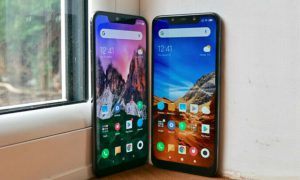 The company Xiaomi in 2018 was at war with leading smartphone manufacturers on different fronts. From budget devices to mid-range smartphones with multiple cameras and beyond, to cutting-edge experimental flagships. There is definitely no shortage of different models Xiaomi.
The company Xiaomi in 2018 was at war with leading smartphone manufacturers on different fronts. From budget devices to mid-range smartphones with multiple cameras and beyond, to cutting-edge experimental flagships. There is definitely no shortage of different models Xiaomi.
Xiaomi Mi The Mix 3 rises above the rest, and the competition is even stronger among more affordable smartphones. The smartphone lineup Xiaomi Mi, including the latest Mi 8 Pro, offers cutting edge specs at reasonable prices. However, the company now Xiaomi has a separate brand Pocophone that offers the best value for money. The Pocophone F1 is available for significantly less than the Xiaomi Mi 8 Pro.
Which of these devices is the best considering the price of each one? Let's find out.
Design
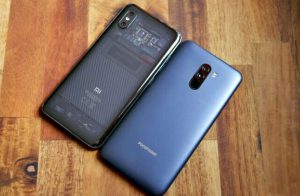
In many aspects, the Pocophone F1 is able to compete on equal terms with the Mi 8 Pro (Mi 8 Explorer Edition), but the appearance is not one of them. In Europe Xiaomi Mi 8 Pro is available in Transparent Titanium color. It has a transparent glass back flanked by a red-edged aluminum bezel on the power button, USB-C connector and cameras.
The components under this clear glass are fake, they're here for beauty. The appearance of both of these devices borrowed something from the models iPhone, but Xiaomi Mi 8 Pro is a more explicit clone of the American manufacturer's products.
The Pocophone F1 looks like a typical smartphone from the last few years and feels cheap due to its plastic back. It also has a red bezel around the rear camera, but otherwise it is a plain black or blue with no spark of ingenuity. There is also a red version and an Armored Edition, but they are not sold in all countries.
The thickness of the F1 body is 8.8 mm versus 7.6 mm for the competitor. This smartphone weighs 182 g versus 177 g for the Xiaomi Mi 8 Pro. When you hold these devices in one hand, the difference in weight can be felt.
Despite being nearly the same width, the more noticeable curvature of the rear window Xiaomi Mi of the 8 Pro means it's easier to reach with your finger to the notifications at the top of the screen.
to the content
Screen

The Pocophone F1 and Xiaomi Mi 8 Pro have almost the same screen resolutions, 1080 x 2246 (403 ppi) and 1080 x 2248 (402 ppi). However, in the second case, the panel AMOLED with a diagonal of 6.21 “is used, while the F1 panel LCD is 6.18”.
Xiaomi prefers colder color temperatures, but the Mi 8 Pro has richer colors and deeper blacks. It supports HDR, and the top screen is covered with Gorilla Glass 5. The Pocophone F1 is content with Gorilla Glass 3.
The screens of both devices have rather large cutouts, the bezels at the bottom are also wide. The Mi 8 Pro contains a lot of useful stuff inside the notch, but the F1 is wasting space.
to the content
Performance
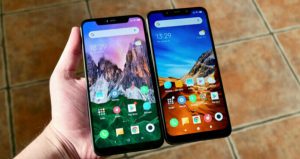
Previous comparisons in the article suggest that the price difference between the two devices is justified. The question may even arise, why compare them with each other at all?
The reason is the speed of work. The international version Xiaomi Mi 8 Pro is powered by a Snapdragon 845 processor with Adreno 630 graphics, 8GB of RAM. Pocophone F1 costs almost half as much and also runs on this processor, only the amount of RAM is 6 GB. An 8 GB version is available in some countries.
In everyday work, these devices are equally fast, there are almost no delays, including when many applications are launched simultaneously. Heavy games are going great too.
Graphic tests such as Geekbench, 3DMark, AnTuTu can confirm these impressions.
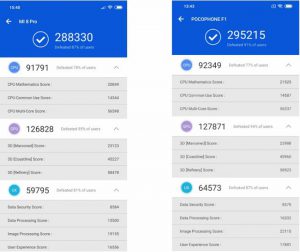
Left – Mi 8 Pro, right – Pocophone F1
to the content
Hardware components and functionality
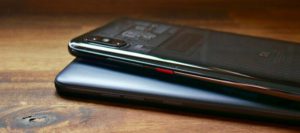
Despite the similarities between the two smartphones, the list of functionalities differs markedly, as well as the available hardware components. It is immediately evident that different goals were pursued in the development of these devices.
Xiaomi Mi The 8 Pro is capable of boasting an in-screen fingerprint scanner. True, his work leaves much to be desired. Recognition works only in 40% of cases, this is below the permissible level. The Pocophone F1 classic fingerprint scanner on the back of the case. It is much faster and more reliable, conveniently located under the dual camera.
In both cases, face unlock is supported in almost any light. These devices have an infrared sensor, although only in Xiaomi Mi 8 Pro is it based on 3D recognition technology. This provides increased reliability.
The presence of a scanner inside the screen in the machine Xiaomi means a decrease in the size of the battery. The capacity is 3000 mAh, which provides about 5 hours of operation with the screen on. The Pocophone F1 has a 4000 mAh battery that lasts for 9 hours.
The F1 wins in terms of audio as it has a headphone jack. Not everyone has headphones with an interface Bluetooth or USB-C, the classic 3.5 mm jack is the preferred option. Unfortunately, on both smartphones, the stereo speakers are directed downward.
Xiaomi Mi 8 Pro has 128GB storage without support for memory cards. The international version of the Pocophone F1 is available with a capacity of 64 and 128 GB, you can install a microSD card.
In addition, the F1 has a liquid cooling system called LiquidCool. It removes heat from the processor and other components to prevent overheating.
In both cases, there is no water protection and wireless charging. Especially unpleasant is the lack of such recharging on Xiaomi Mi 8 Pro, where the back is glass.
to the content
Cameras
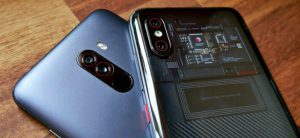
The Pocophone F1 has a dual rear camera with a 12MP primary sensor and a 5MP secondary sensor for depth analysis. We can immediately say that the quality of photos is not the strongest point of this device.
With the right lighting, this unit is capable of capturing quality images. This primarily applies to outdoor photography. However, if the light gets slightly worse, the pictures immediately look underexposed or overexposed.

Main camera Xiaomi Mi 8 Pro 12 MP, auxiliary 12 MP with telephoto lens. This combination allows you to get excellent pictures in almost all situations, except perhaps in complete darkness.
The examples show the difference in the quality of photographs. The pictures were taken in the middle of the day, and in the dark the Pocophone F1's results are even worse.
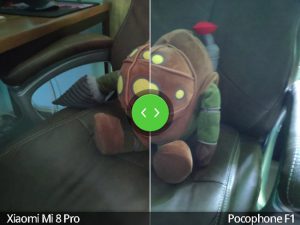
The camera applications on the two devices are almost identical. Both have AI scene recognition, but the quality is higher on Xiaomi Mi 8 Pro.

As for the front camera, both devices have 20 MP sensors. Pixel binding is supported to reduce digital noise and improve the quality of shooting in the dark.
to the content
Software

Both smartphones run on Android 8.1 with shell MIUI 9. They need to be updated to version MIUI 10 and F1 has already received an update to Android 9.0.
However, even without this system MIUI 10 largely repeats the clean version Android, albeit with a set of applications Xiaomi. Some of them are unnecessary copies of Google apps. There is also a muted color palette here.
Pocophone does not run on a clean version MIUI, as a separate version of the system called Poco Launcher is installed here. The difference is minimal, in many respects the choice will be a matter of taste. Poco Launcher offers to enable the app list, while MIUI 10 does without it. Optionally, you can download Poco Launcher from the app store Android.
Any of these smartphones has all the advantages and disadvantages MIUI 10, and these disadvantages are quite noticeable. That means no notification icons in the status bar, confusing menus and ads.
to the content
Price and availability
Xiaomi Mi 8 Pro on Yandex.Market costs 32,000 rubles. for version 6/128 GB and 37,500 rubles. for version 8/128 GB. Pocophone F1 will cost 18,400 rubles. for version 6/64 GB and 25,000 rubles. for 6/128 GB. Both devices are already on sale in stores.
to the content
Conclusion
The choice of a smartphone comes down to whether you want to save more than RUB 10,000. at the expense of style and some options or not. Xiaomi Mi 8 Pro is nicer to look at and looks more premium. However, this is only external superiority.
Despite its nondescript design, the F1 has the power of an elite Android smartphone at a significantly lower price point.
This is not to say that Xiaomi Mi 8 Pro does not deserve a higher price. Here, the developers offer an uncompromising device, especially ahead of the Pocophone F1 in terms of camera quality.
If photo quality is not your main concern, the Pocophone F1 can be attractive thanks to its longer battery life and the same high performance. This device offers quality basic features without obvious drawbacks. For those who want to pay more, the Xiaomi Mi 8 Pro will be a great purchase, not inferior in any way to more expensive devices at a price of about 40,000 rubles.
